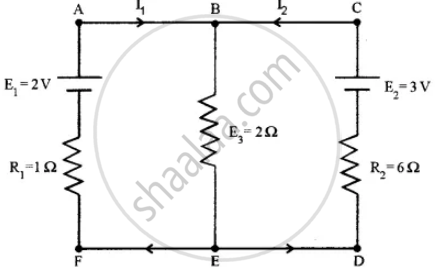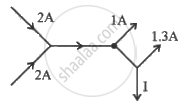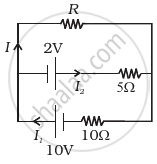Advertisements
Advertisements
प्रश्न
In the circuit shown in the figure below, E1 and E2 are two cells having emfs 2 V and 3 V respectively, and negligible internal resistance. Applying Kirchhoff’s laws of electrical networks, find the values of currents l1 and I2.

उत्तर
The distribution of current in the circuit is as shown in figure

Applying Kirchoff's laws (Loop law) to loop ABEFA
-2 (I1 + I2) - I1 × 1 + 2 = 0
2 - I1 - 2(I1 + I2) = 0
⇒ 2 - 3I1 - 2I2 = 0 .....(i)
Applying to loop BCDEB
-3 + 6I2 + 2(I1 + I2) = 0
⇒ 3 - 6I2 - 2I1 - 2I2 = 0
⇒ 3 - 8I2 - 2I1 = 0 ....(ii)
Solving equations (i) and (ii), we can write
I1 = `1/2`A , I2 = `1/4` A
APPEARS IN
संबंधित प्रश्न
Use Kirchhoff's rules to obtain conditions for the balance condition in a Wheatstone bridge.
Given the resistances of 1 Ω, 2 Ω, 3 Ω, how will be combine them to get an equivalent resistance of (11/5) Ω?
Given the resistances of 1 Ω, 2 Ω, 3 Ω, how will be combine them to get an equivalent resistance of (6/11) Ω?
Twelve wires, each of equal resistance r, are joined to form a cube, as shown in the figure. Find the equivalent resistance between the diagonally-opposite points a and f.

Solve the following question.
Using Kirchhoff’s rules, calculate the current through the 40 Ω and 20 Ω resistors in the following circuit.

A copper wire of 10-6 m2 area of cross-section, carries a current of 2 A. If the number of electrons per cubic meter is 8 × 1028, calculate the current density and average drift velocity.
The figure below shows current in a part of electric circuit. The current I is ______.

Why are alloys used for making standard resistance coils?
Two cells of voltage 10V and 2V and internal resistances 10Ω and 5Ω respectively, are connected in parallel with the positive end of 10V battery connected to negative pole of 2V battery (Figure). Find the effective voltage and effective resistance of the combination.

State the two Kirchhoff’s rules used in the analysis of electric circuits and explain them.
